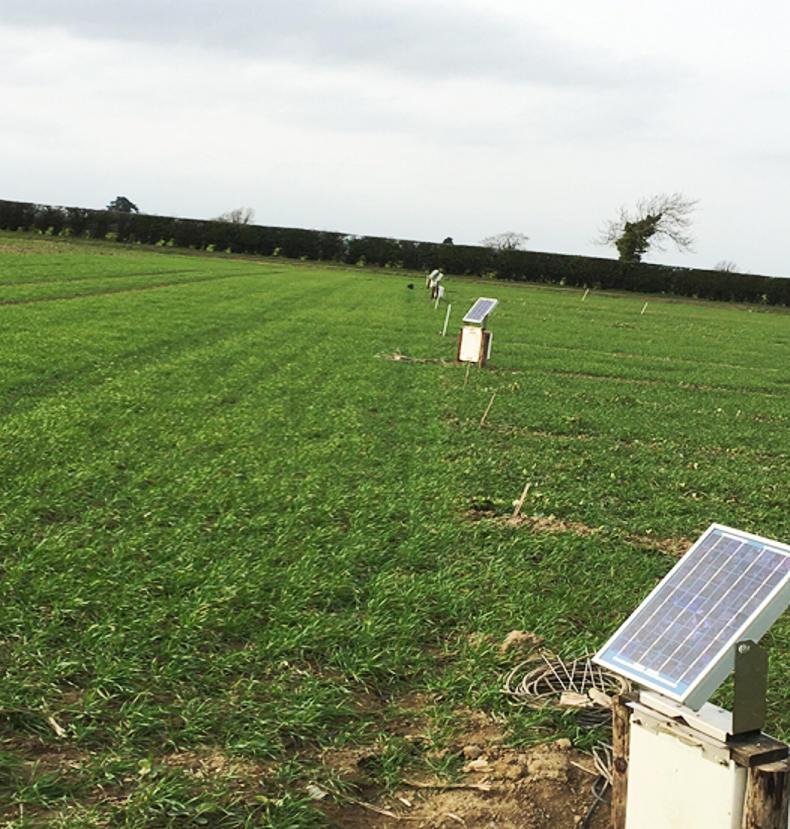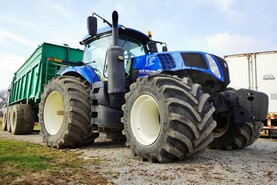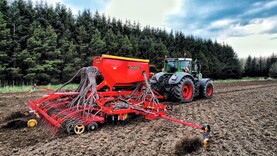There is an increasing awareness of the importance of plant roots in the growth of plants, in particular in the formation and delivery of yield in cereal crops. This is a difficult part of the plant to monitor and measure, but new technologies are helping us do that.
The Consus research programme is a five-year project run by UCD that looks at how we can use digital tools to improve our understanding of yield creation and management. The project places particular emphasis on the optimisation of agri-food production systems, with the objective of making food production more efficient while lowering its environmental impact.
A second green revolution will be required to meet the world’s growing demand for food
Wheat is one of the most important staple food crops consumed globally, with an estimated 761m tonnes produced in 2019. However, the increase in global population is happening at a faster pace than any increases in wheat production. This will make for a significant challenge in the future.
A second green revolution will be required to meet the world’s growing demand for food. This will involve increasing the tolerance of major staple foods like wheat to abiotic stresses, such as soil compaction, drought and soil salinity.
Compaction and soil damage
Important plant establishment processes involve the in-situ interactions of roots in soil. One of the major environmental impacts in arable crop production is soil compaction. With farm sizes increasing, producers have opted for bigger and heavier machinery to ensure timeliness of cropping operations.
Soil compaction is a major cause of soil physical degradation worldwide
The challenge is that they increase the risk of soil compaction.
Soil compaction is a major cause of soil physical degradation worldwide. In Europe alone, it affects over 33m hectares of farm land.
Such damaged soil negatively affects a plant’s ability to acquire water and nutrients
The increased size of agricultural machinery, coupled with growing farm sizes, have led to additional compaction and damage pressures, as soils get cultivated in adverse or less than optimum conditions.
Such damaged soil negatively affects a plant’s ability to acquire water and nutrients.
This can be because of poorer and coarser structure, but the compaction can also alter the size and direction of the plant roots, known as the root architecture.
Researching the compaction issue
Crop establishment techniques are one element of the potential solution to managing soil health and soil compaction. The research we are involved in is looking at cultivation strategy as the key component to maximise soil health while minimising soil compaction for cereal production.
Different crops require different soil physical properties for successful establishment
Seedbed preparation is crucial for crop establishment, growth, and ultimately, yield.
However, different crops require different soil physical properties for successful establishment.
There is a need to investigate the capacity of reduced or low disturbance techniques to improve soil health, reduce establishment costs, increase sowing capacity and facilitate alternative sowing dates.
For this trial, we set up a series of treatments consisting of four cultivation systems and two tyre-inflation pressures.

Two tyre pressures were used to create the levels of compaction on which the sowing systems were tested.
Our objective was to measure the interaction between tillage depth, the number of tractor and tillage passes and tyre inflation pressure.
The field-induced compaction arising from this was investigated by measuring physical parameters of soil and root architecture.
This work was done at the UCD’s Lyons Estate research farm. The initial compaction was applied through high and low tyre pressure while using rear axle 650/65 R42 cross-ply Trelleborg® tyres during primary and secondary cultivations.
The tractor had a total weight of 6,980kg over two axles. We used 1.5 bar (150kPa) and 0.8 bar (80kPa) pressure in both front and rear tyres to generate the high and low pressure respectively. For this study, we used controlled traffic wheelings for each cultivation and sowing pass to replicate the impact of compaction in the plots.
Cultivation treatments
The cultivation practices used were:
Conventional plough, till and sow. Shallow disc non-inversion cultivation and sow. Deep non-inversion tillage and sow. Zero-till and sow. All of these treatments were carried out at both high and low tyre pressure and replicated four times. Kellys of Borris were a key partner in this research.

One of the drills used in the UCD experiment, supplied by Kellys of Borris.
They supplied the equipment for sowing (Horsch Joker CT, Horsch Pronto DC, and Horsch Avatar SD) and supplied a Claas tractor for the trials, which was set up with the necessary terminals for operating the equipment.
Irish fields and circumstances
For the research to have applicability in Ireland, it was important that we undertook the trials using equipment that is available to commercial growers. One of the big advantages of using a single equipment brand was the potential for consistency across all the treatments with regard to machine design, disc set-up etc. Sowing technology was also consistent across all the trials, so we can assess the crop performance under the different cultivation treatments. We are very grateful to Kellys for this support.

A weather station was used to assess the many weather-related parameters of plant growth during the season.
To assess root architecture, soil cores were taken from each treatment at tillering, stem extension and flowering. Additionally, soil physical and chemical properties were measured.
The sites were furnished to measure soil moisture throughout the growing season, as lack of moisture at critical points in plant development is one of the key yield-limiting factors. The site was also equipped with a fully instrumented weather station.

Instrumentation was used in the different treatments to help measure underground parameters like moisture availability.
Measuring root growth
Soil cores were assessed for root development using an X-Ray CT scanner. This allows a visual 3D assessment of the number, volume, shape and twisting of the roots, as well as soil pore space, which is critical for drainage and water conductivity within the soil.
From these assessments, interactive 3D images of the root architecture can be developed for the wheat plants at the key growth stages and used to assess the impact of each cultivation treatment to enable comparisons.

Some of the Horsch equipment supplied for the research by Kellys of Borris.
Images from the CT scans at flagleaf emergence showed shallow till and low pressure tyres had six times greater root volume and surface area than roots under zero-till treatment with low pressure tyres.
Results
The image shown below is a 3D composite of the many CT scans taken from one of the treatments at GS 39.

A 3D composite of the many root scans taken at GS 39, following the low ground pressure tyre treatment and shallow cultivation establishment.
This shows the root structure following low ground pressure tyres (0.7 bar) and shallow tillage. In this treatment the total root volume measured 88.76mm3 and the total surface area was 3,693.46mm2.
When compared with the same low ground pressure tyres using zero tillage, the total root volume measured 14.64mm3 and the root surface area measured was 612.34mm2.
The results show clear observed differences in the root architecture numbers between the different cultivation systems
These results are from year one of the three growing seasons that will be assessed.
The results show clear observed differences in the root architecture numbers between the different cultivation systems. When the yield assessments are available for each of the treatments, we will be able to say if these root differences are having a significant impact on crop yield.
Continuous use of the same system may alter the root architecture over time
The experiment will be carried out in the same location for the next two seasons to look at the impact over time of using the same establishment systems. It must be noted that all the treatments were tested on land that had been managed previously in a uniform manner.
Continuous use of the same system may alter the root architecture over time.
Clearly, soil health is a key part of sustainable farming systems and the future development of agricultural production. How we influence soil health will be determined by the cultivation systems we use, the soil properties, soil moisture levels and axle loads, as well as the rooting functions of the crop.
These trials, which are part of other experimental work on soil/tyre interactions and digital agriculture, will help us address these issues.
Research is ongoing at UCD looking at the effect of soil compaction and sowing system on root growth and architecture.The first year of the experiment showed much more root growth where the soil was loosened.It seems likely that the level of root growth under zero-till will increase over time as the soil improves.This research will be repeated for two more years.
There is an increasing awareness of the importance of plant roots in the growth of plants, in particular in the formation and delivery of yield in cereal crops. This is a difficult part of the plant to monitor and measure, but new technologies are helping us do that.
The Consus research programme is a five-year project run by UCD that looks at how we can use digital tools to improve our understanding of yield creation and management. The project places particular emphasis on the optimisation of agri-food production systems, with the objective of making food production more efficient while lowering its environmental impact.
A second green revolution will be required to meet the world’s growing demand for food
Wheat is one of the most important staple food crops consumed globally, with an estimated 761m tonnes produced in 2019. However, the increase in global population is happening at a faster pace than any increases in wheat production. This will make for a significant challenge in the future.
A second green revolution will be required to meet the world’s growing demand for food. This will involve increasing the tolerance of major staple foods like wheat to abiotic stresses, such as soil compaction, drought and soil salinity.
Compaction and soil damage
Important plant establishment processes involve the in-situ interactions of roots in soil. One of the major environmental impacts in arable crop production is soil compaction. With farm sizes increasing, producers have opted for bigger and heavier machinery to ensure timeliness of cropping operations.
Soil compaction is a major cause of soil physical degradation worldwide
The challenge is that they increase the risk of soil compaction.
Soil compaction is a major cause of soil physical degradation worldwide. In Europe alone, it affects over 33m hectares of farm land.
Such damaged soil negatively affects a plant’s ability to acquire water and nutrients
The increased size of agricultural machinery, coupled with growing farm sizes, have led to additional compaction and damage pressures, as soils get cultivated in adverse or less than optimum conditions.
Such damaged soil negatively affects a plant’s ability to acquire water and nutrients.
This can be because of poorer and coarser structure, but the compaction can also alter the size and direction of the plant roots, known as the root architecture.
Researching the compaction issue
Crop establishment techniques are one element of the potential solution to managing soil health and soil compaction. The research we are involved in is looking at cultivation strategy as the key component to maximise soil health while minimising soil compaction for cereal production.
Different crops require different soil physical properties for successful establishment
Seedbed preparation is crucial for crop establishment, growth, and ultimately, yield.
However, different crops require different soil physical properties for successful establishment.
There is a need to investigate the capacity of reduced or low disturbance techniques to improve soil health, reduce establishment costs, increase sowing capacity and facilitate alternative sowing dates.
For this trial, we set up a series of treatments consisting of four cultivation systems and two tyre-inflation pressures.

Two tyre pressures were used to create the levels of compaction on which the sowing systems were tested.
Our objective was to measure the interaction between tillage depth, the number of tractor and tillage passes and tyre inflation pressure.
The field-induced compaction arising from this was investigated by measuring physical parameters of soil and root architecture.
This work was done at the UCD’s Lyons Estate research farm. The initial compaction was applied through high and low tyre pressure while using rear axle 650/65 R42 cross-ply Trelleborg® tyres during primary and secondary cultivations.
The tractor had a total weight of 6,980kg over two axles. We used 1.5 bar (150kPa) and 0.8 bar (80kPa) pressure in both front and rear tyres to generate the high and low pressure respectively. For this study, we used controlled traffic wheelings for each cultivation and sowing pass to replicate the impact of compaction in the plots.
Cultivation treatments
The cultivation practices used were:
Conventional plough, till and sow. Shallow disc non-inversion cultivation and sow. Deep non-inversion tillage and sow. Zero-till and sow. All of these treatments were carried out at both high and low tyre pressure and replicated four times. Kellys of Borris were a key partner in this research.

One of the drills used in the UCD experiment, supplied by Kellys of Borris.
They supplied the equipment for sowing (Horsch Joker CT, Horsch Pronto DC, and Horsch Avatar SD) and supplied a Claas tractor for the trials, which was set up with the necessary terminals for operating the equipment.
Irish fields and circumstances
For the research to have applicability in Ireland, it was important that we undertook the trials using equipment that is available to commercial growers. One of the big advantages of using a single equipment brand was the potential for consistency across all the treatments with regard to machine design, disc set-up etc. Sowing technology was also consistent across all the trials, so we can assess the crop performance under the different cultivation treatments. We are very grateful to Kellys for this support.

A weather station was used to assess the many weather-related parameters of plant growth during the season.
To assess root architecture, soil cores were taken from each treatment at tillering, stem extension and flowering. Additionally, soil physical and chemical properties were measured.
The sites were furnished to measure soil moisture throughout the growing season, as lack of moisture at critical points in plant development is one of the key yield-limiting factors. The site was also equipped with a fully instrumented weather station.

Instrumentation was used in the different treatments to help measure underground parameters like moisture availability.
Measuring root growth
Soil cores were assessed for root development using an X-Ray CT scanner. This allows a visual 3D assessment of the number, volume, shape and twisting of the roots, as well as soil pore space, which is critical for drainage and water conductivity within the soil.
From these assessments, interactive 3D images of the root architecture can be developed for the wheat plants at the key growth stages and used to assess the impact of each cultivation treatment to enable comparisons.

Some of the Horsch equipment supplied for the research by Kellys of Borris.
Images from the CT scans at flagleaf emergence showed shallow till and low pressure tyres had six times greater root volume and surface area than roots under zero-till treatment with low pressure tyres.
Results
The image shown below is a 3D composite of the many CT scans taken from one of the treatments at GS 39.

A 3D composite of the many root scans taken at GS 39, following the low ground pressure tyre treatment and shallow cultivation establishment.
This shows the root structure following low ground pressure tyres (0.7 bar) and shallow tillage. In this treatment the total root volume measured 88.76mm3 and the total surface area was 3,693.46mm2.
When compared with the same low ground pressure tyres using zero tillage, the total root volume measured 14.64mm3 and the root surface area measured was 612.34mm2.
The results show clear observed differences in the root architecture numbers between the different cultivation systems
These results are from year one of the three growing seasons that will be assessed.
The results show clear observed differences in the root architecture numbers between the different cultivation systems. When the yield assessments are available for each of the treatments, we will be able to say if these root differences are having a significant impact on crop yield.
Continuous use of the same system may alter the root architecture over time
The experiment will be carried out in the same location for the next two seasons to look at the impact over time of using the same establishment systems. It must be noted that all the treatments were tested on land that had been managed previously in a uniform manner.
Continuous use of the same system may alter the root architecture over time.
Clearly, soil health is a key part of sustainable farming systems and the future development of agricultural production. How we influence soil health will be determined by the cultivation systems we use, the soil properties, soil moisture levels and axle loads, as well as the rooting functions of the crop.
These trials, which are part of other experimental work on soil/tyre interactions and digital agriculture, will help us address these issues.
Research is ongoing at UCD looking at the effect of soil compaction and sowing system on root growth and architecture.The first year of the experiment showed much more root growth where the soil was loosened.It seems likely that the level of root growth under zero-till will increase over time as the soil improves.This research will be repeated for two more years. 











 This is a subscriber-only article
This is a subscriber-only article










SHARING OPTIONS: